Tiny Kitty, Big City: A Visit with Tim Miller
 March 16th, 2021 by jules
March 16th, 2021 by jules
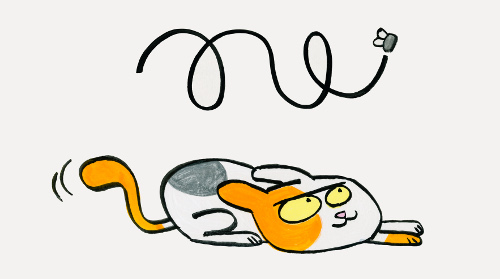
It’s a pleasure to have a visit once again from author-illustrator Tim Miller, who takes a deep dive here into his newest picture book, Tiny Kitty, Big City (Balzer + Bray, March 2021), and shares some process images as well. The story, told in short and punchy two-word phrases on each spread, is one of a stray kitten who eventually finds a home — but not after wandering, lost and during winter, throughout New York City. It may be crowded and loud and scary for the tiny creature, but kitty is brave — and survives, thanks to the kindness of strangers.
This book is a love song to cats and New York City. It nearly hums with the magic of the Big Apple in winter, all brought to life in Tim’s vibrant, spacious, and unfussy cartoon style. I thank him for visting today to talk about the gouache (and cat hair) illustrations, how this story was born, and much more. Let’s get to it.
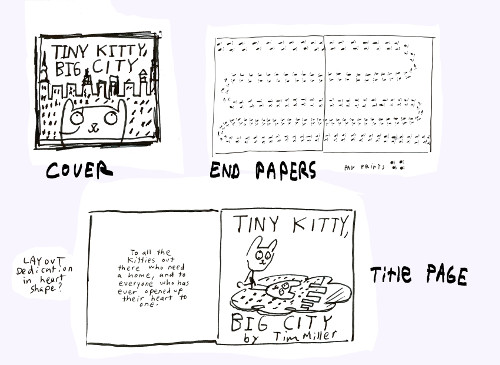
(Click to enlarge)
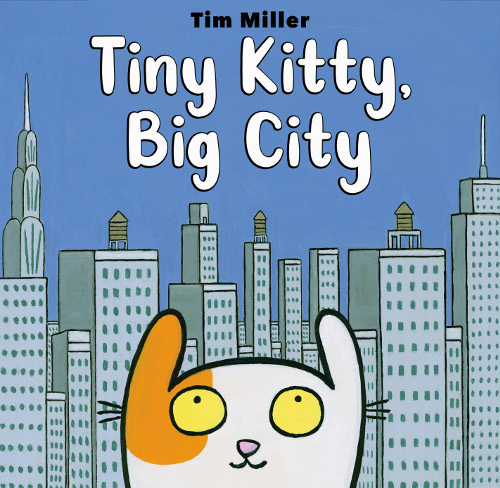
(Click to enlarge)
Jules: This was inspired by a true stray-cat story, yes?
Tim: The idea for Tiny Kitty, Big City first came to me from a scribble I made just playing around in my sketchbook. I drew a small cat looking up at the giant Chrysler Building, because I thought it was a fun game to contrast big and small.
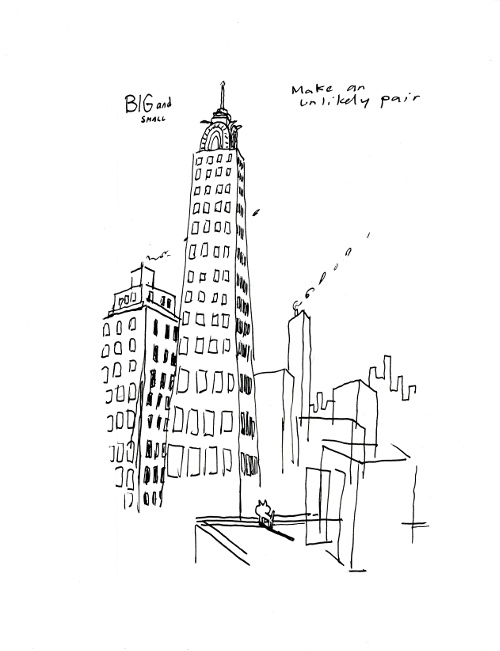
I had recently adopted a rescue cat and was working at the Queens Museum at the time, leading school tours of the Panorama of New York City [pictured below], which is a giant to-scale model of NYC from the 1964 World’s Fair. So, I think the drawing was an unconscious pairing of the two.
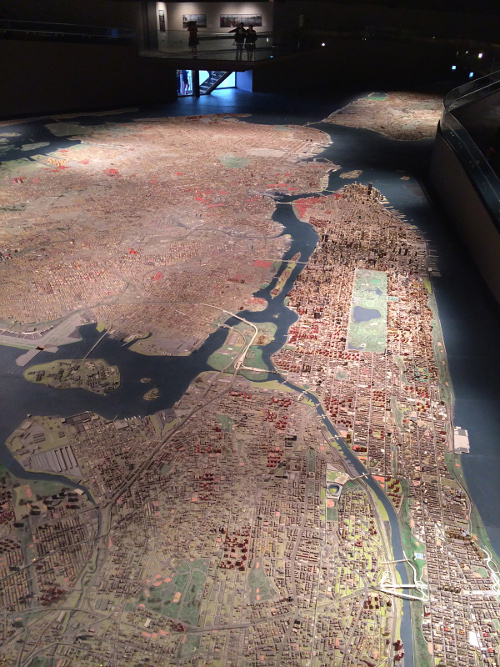
I remember that I shared the sketch on Facebook, and since I had to come up with a catchy caption, I wrote: “Tiny Kitty, Big City.” And that was the light-bulb moment when I realized, “BOOK!” I toyed with the concept for a while but couldn’t get anywhere with it, so I filed it away and forgot about it.
About three years later, I found a stray cat and her litter of kittens when I was parking my car in Queens. They were living in a beat-up cardboard box under the elevated subway train. I fed them for about a week until I was able to rescue them. I fostered them all until I could find them new homes with the help of a local rescue called Jersey Cats. It was the experience of seeing how the stray and her litter had to survive and imagining what that felt like through their eyes that reminded me of the idea and helped me understand how to make it work.
(Click image to enlarge)
(Click image to enlarge)
Jules: Was the text in the manuscript always a two-word construction on each page? Or did it alter over time?
Tim: In my first drafts of the story, I played around with Kitty speaking to the audience directly, but I realized it came off too overt and sentimental. Then I paired things down to just brief descriptions of key moments to map out the arc for myself and, in the process, had an epiphany that I didn’t need to use whole sentences but could shave everything down to key words. From there, I figured out that I could link everything together by playing Kitty and City off each other, giving it rhythm and a tempo.
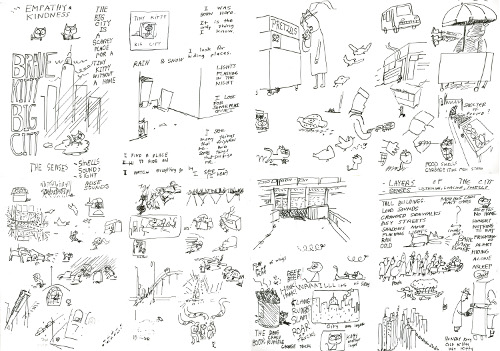
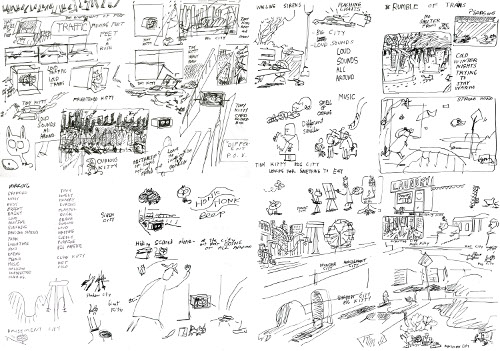
(Click each image to enlarge)
Jules: Did you have beginning readers specifically in mind as you wrote this?
Tim: No, I didn’t really think about it in the beginning. I was just focused on figuring out how to construct the story from the different scenes that I had in mind. As I connected words to each of these and began piecing together the narrative, I basically stumbled into it by accident and realized what I had. Then, I became more conscious of working with that audience in mind.
These below are deleted scenes from the first draft. I loved them but cut them to make the arc less stark:
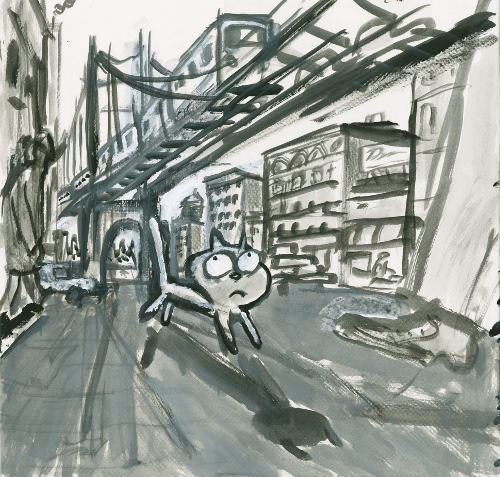
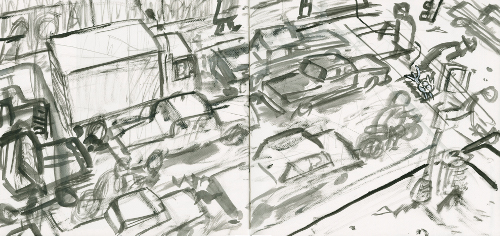
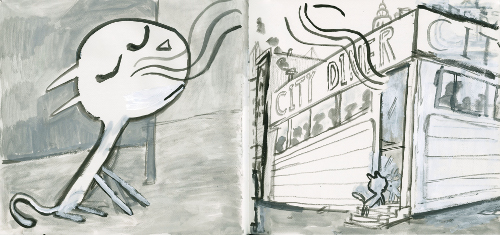
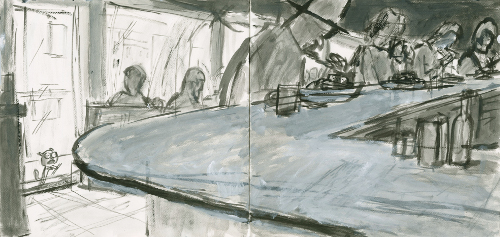
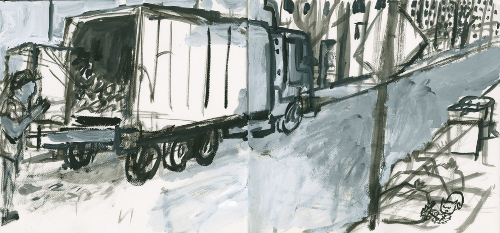
Jules: Can you talk about your decision to use acrylic gouache and cat hairs as the medium?
Tim: Ha! That makes me really happy that you caught that. Now I know just how closely you look at everything.
The acrylic gouache was by choice. The cat hairs were not. My cat Keiko just crawled up onto my lap as I’m writing this, which is the same thing that she did when I was painting the book. She sheds a lot and her hair gets everywhere, which is how some ended up in the finishes. I encourage readers to scour the book with a magnifying glass to see how many they can find.
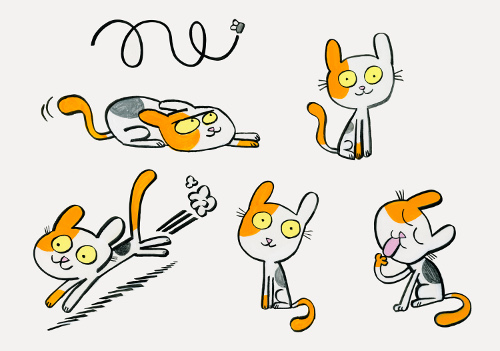
The decision to work with acrylic gouache had nothing to do with the cat, though. I felt a need to make something more physical. I wanted Tiny Kitty, Big City to have a strong visceral quality to it. I wanted to give everything a greater sense of immediacy that jumps off the page. I also tried to let more of my hand show through than I usually do in my handling of the paint. I like that the struggle in it lends a sense of sincerity to the story that’s both heartfelt and real.
(Click to enlarge)
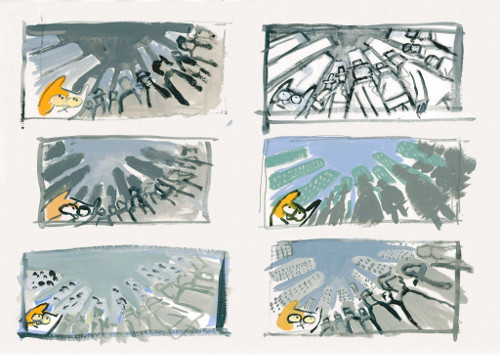
(Click to enlarge)
-small.jpeg)
— Same spread in its final form
(uncropped and sans text)
(Click to enlarge)
Jules: There are a lot of intriguing perspectives in this book. How’d you get into a cat’s brain for that?
Tim: This was the most important part of the book to me — and the main spark that motivated everything. When I realized that the story was about seeing life in the city through Kitty’s eyes, it became a fun game to play. I felt it was necessary to really push things and to make it as clear as possible to the reader that they are seeing the world from her point of view. I thought a lot about André François and Saul Steinberg, because I love how they push perspectives to the extreme, especially with a childlike simplicity.
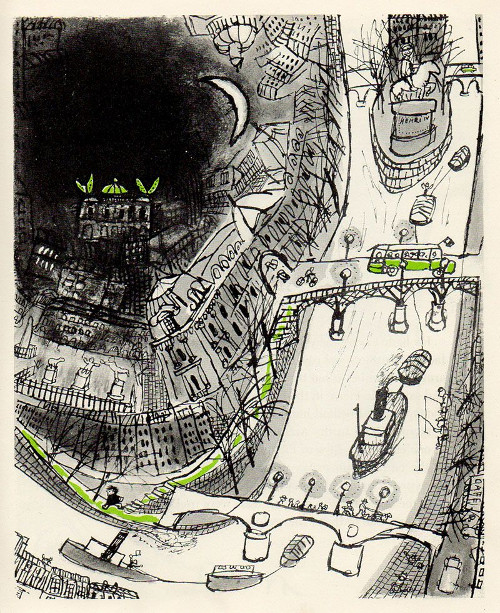
illustrated by André François
(Click image to enlarge)

(Click image to enlarge)

(Click image to enlarge)
Jules: This book also feels like a love letter to NYC. Did you intend that?
Tim: No. It really wasn’t intentional at first. The city was just an imaginary place in the beginning, but then my editor Donna Bray cued into the fact that a lot of my locations had hints of the real NYC, so she encouraged me to hone in on that. My laziness resisted, because it meant getting details right, but then I started going out in the city to do sketches — and I got into it. I liked the idea that it could ground the story in something real that the audience could relate to. Then, in fleshing everything out, all my sentiment for NYC just kind of poured out. I think that adds a nice layer to heart of the story as well.
-small.jpeg)
(Click to enlarge)



(Click each to enlarge)
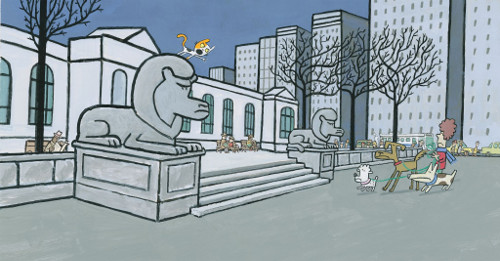
The final library spread (sans text)
(Click to enlarge)
Jules: Inquiring minds wanna know your cats’ names.
Tim: They’re so happy you asked about them, because they could care less about the book. We have three rescue cats. You met Keiko before. She’s the latest addition to the family and was my fault. My wife, Nancy, was volunteering at a kitten adoption event hosted by our friends at Jersey Cats. I showed up to check it out and met eyes with Keiko, a calico/tabby mix, and told Nancy, “I WANT HER!” Nancy shrugged her shoulders and that was that. We also have a tuxedo named Lulu and a black cat named Jerry. Keiko is basically my sidekick, and the other two much prefer Nancy over me.
(Click image to enlarge)

(Click image to enlarge)
(Click image to enlarge)
Jules: Anything else you want to say about this book?
Tim: I would just like to give a special shout-out to our friends at Jersey Cats, the non-profit cat rescue who helped find forever homes for the rescue kitties who were the inspiration for book. We also adopted Jerry, Lulu, and Keiko from them. If anyone out there is interested in supporting the good work they do, please visit them at jerseycats.org.


A final spread from the book (sans text);
click either image to see spread in its entirety …
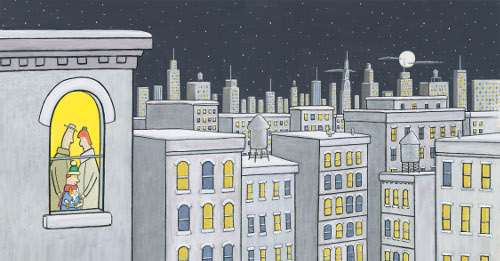
The book’s last spread (sans text);
click to enlarge …
.gif)
TINY KITTY, BIG CITY. Copyright © 2021 by Tim Miller. Published by Balzer + Bray, an imprint of HarperCollins, New York. All images reproduced by permission of Tim Miller.

